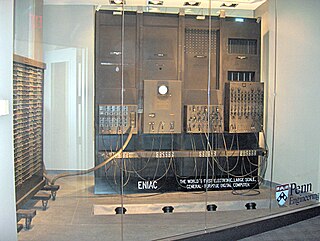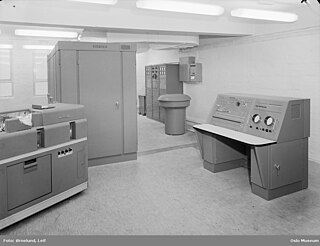
In a computer's central processing unit (CPU), the accumulator is a register in which intermediate arithmetic logic unit results are stored.

The Electronic Delay Storage Automatic Calculator (EDSAC) was an early British computer. Inspired by John von Neumann's seminal First Draft of a Report on the EDVAC, the machine was constructed by Maurice Wilkes and his team at the University of Cambridge Mathematical Laboratory in England. EDSAC was the second electronic digital stored-program computer, after the Manchester Mark 1, to go into regular service.

The LEO was a series of early computer systems created by J. Lyons and Co. The first in the series, the LEO I, was the first computer used for commercial business applications.

ENIAC was the first programmable, electronic, general-purpose digital computer, completed in 1945. Other computers had some of these features, but ENIAC was the first to have them all. It was Turing-complete and able to solve "a large class of numerical problems" through reprogramming.
In computing, especially digital signal processing, the multiply–accumulate (MAC) or multiply-add (MAD) operation is a common step that computes the product of two numbers and adds that product to an accumulator. The hardware unit that performs the operation is known as a multiplier–accumulator ; the operation itself is also often called a MAC or a MAD operation. The MAC operation modifies an accumulator a:

A mechanical calculator, or calculating machine, is a mechanical device used to perform the basic operations of arithmetic automatically, or (historically) a simulation such as an analog computer or a slide rule. Most mechanical calculators were comparable in size to small desktop computers and have been rendered obsolete by the advent of the electronic calculator and the digital computer.
Electronic data processing (EDP) or business information processing can refer to the use of automated methods to process commercial data. Typically, this uses relatively simple, repetitive activities to process large volumes of similar information. For example: stock updates applied to an inventory, banking transactions applied to account and customer master files, booking and ticketing transactions to an airline's reservation system, billing for utility services. The modifier "electronic" or "automatic" was used with "data processing" (DP), especially c. 1960, to distinguish human clerical data processing from that done by computer.

Starting at the end of the nineteenth century, well before the advent of electronic computers, data processing was performed using electromechanical machines collectively referred to as unit record equipment, electric accounting machines (EAM) or tabulating machines. Unit record machines came to be as ubiquitous in industry and government in the first two-thirds of the twentieth century as computers became in the last third. They allowed large volume, sophisticated data-processing tasks to be accomplished before electronic computers were invented and while they were still in their infancy. This data processing was accomplished by processing punched cards through various unit record machines in a carefully choreographed progression. This progression, or flow, from machine to machine was often planned and documented with detailed flowcharts that used standardized symbols for documents and the various machine functions. All but the earliest machines had high-speed mechanical feeders to process cards at rates from around 100 to 2,000 per minute, sensing punched holes with mechanical, electrical, or, later, optical sensors. The operation of many machines was directed by the use of a removable plugboard, control panel, or connection box. Initially all machines were manual or electromechanical. The first use of an electronic component was in 1937 when a photocell was used in a Social Security bill-feed machine. Electronic components were used on other machines beginning in the late 1940s.

The DEUCE was one of the earliest British commercially available computers, built by English Electric from 1955. It was the production version of the Pilot ACE, itself a cut-down version of Alan Turing's ACE.
The APE(X)C, or All Purpose Electronic (X) Computer series was designed by Andrew Donald Booth at Birkbeck College, London in the early 1950s. His work on the APE(X)C series was sponsored by the British Rayon Research Association. Although the naming conventions are slightly unclear, it seems the first model belonged to the BRRA. According to Booth, the X stood for X-company.
Booth's multiplication algorithm is a multiplication algorithm that multiplies two signed binary numbers in two's complement notation. The algorithm was invented by Andrew Donald Booth in 1950 while doing research on crystallography at Birkbeck College in Bloomsbury, London. Booth's algorithm is of interest in the study of computer architecture.

International Computers and Tabulators or ICT was a British computer manufacturer, formed in 1959 by a merger of the British Tabulating Machine Company (BTM) and Powers-Samas. In 1963 it acquired the business computer divisions of Ferranti. It exported computers to many countries and in 1968 became part of International Computers Limited (ICL).
The ICT 1301 and its smaller derivative ICT 1300 were early business computers from International Computers and Tabulators. Typical of mid-sized machines of the era, they used core memory, drum storage and punched cards, but they were unusual in that they were based on decimal logic instead of binary.
The British Tabulating Machine Company (BTM) was a firm which manufactured and sold Hollerith unit record equipment and other data-processing equipment. During World War II, BTM constructed some 200 "bombes", machines used at Bletchley Park to break the German Enigma machine ciphers.

Powers-Samas was a British company which sold unit record equipment.

Andrew Donald Booth was a British electrical engineer, physicist and computer scientist, who was an early developer of the magnetic drum memory for computers. He is known for Booth's multiplication algorithm. In his later career in Canada he became president of Lakehead University.

The National Museum of Computing is a UK-based museum that is dedicated to collecting and restoring historic computer systems, and is home to the world's largest collection of working historic computers. The museum is located on Bletchley Park in Milton Keynes, Buckinghamshire. It opened in 2007 in Block H – the first purpose-built computer centre in the world, having housed six of the ten Colossus computers that were in use at the end of World War II.
Kathleen Hylda Valerie Booth was a British computer scientist and mathematician who wrote the first assembly language and designed the assembler and autocode for the first computer systems at Birkbeck College, University of London. She helped design three different machines including the ARC, SEC, and APE(X)C.
ICT 1900 was a family of mainframe computers released by International Computers and Tabulators (ICT) and later International Computers Limited (ICL) during the 1960s and 1970s. The 1900 series was notable for being one of the few non-American competitors to the IBM System/360, enjoying significant success in the European and British Commonwealth markets.













